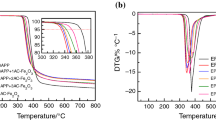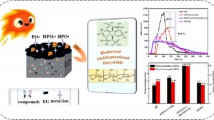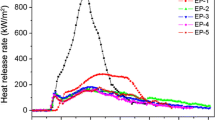Abstract
β-FeOOH nanorods were synthesized and introduced into ammonium polyphosphate (APP) and epoxy resins (EP) composites, with subsequent investigation into improving the fire safety of epoxy resins (EP) composites. The limited oxygen index, UL-94 test and cone calorimeter test were adopted to investigate the flame retardant properties of the composites, and thermogravimetric analysis was used to study the thermal performance of the composites. The cone calorimetry results revealed that synergistic effects between β-FeOOH nanorods and APP can lead to not only the reduction of peak heat release rate compared with those of EP (85.6% reduction), but also the improvement on the smoke suppression performance such as CO, CO2 and SPR. Raman spectroscopy, FTIR and X-ray photoelectron spectroscopy of the char layers were adopted to investigate the flame retardant mechanism of the flame retardants composites. Generally, the reduced fire hazard of epoxy resins composites is due to synergistic effects between β-FeOOH nanorods and APP, which will provide stable char layers to trap the degrading polymer radicals.









Similar content being viewed by others
References
Giang T, Park J, Cho I. Effect of backbone moiety in epoxies on thermal conductivity of epoxy/alumina composite. Polym Compos. 2013;34:468–76.
Jerzy J, Chruściel EL. Modification of epoxy resins with functional silanes, polysiloxanes, silsesquioxanes, silica and silicates. Prog Polym Sci. 2015;41:67–121.
Benyahya S, Aouf C, Caillol S. Functionalized green tea tannins as phenolic prepolymers for bio-based epoxy resins. Ind Crops Prod. 2014;53:296–307.
Sun D, Yao Y. Synthesis of three novel phosphorus-containing flame retardants and their application in epoxy resins. Polym Degrad Stab. 2011;96:1720–4.
Tao Z, Ting W, Haonan X. Simultaneously improving flame retardancy and dynamic mechanical properties of epoxy resin nanocomposites through synergistic effect of zirconium phenylphosphate and POSS. J Therm Anal Calorim. 2018;135(4):2117–24.
Zhang Y. Highly effective P-P synergy of a novel DOPO-based flame retardant for epoxy resin. Ind Eng Chem Res. 2017;56(5):1245–55.
Feng CM, Zhang Y, Lang D. Flame retardant mechanism of a novel intumescent flame retardant polypropylene. Procedia Eng. 2013;52:97–104.
Brehme S, Schartel B, Goebbels J. Phosphorus polyester versus aluminium phosphinate in poly(butylene terephthalate) (PBT): Flame retardancy performance and mechanisms. Polym Degrad Stab. 2011;96:875–84.
Zhang JH, Kong QH, Yang LW, Wang DY. Few layered Co(OH)2 ultrathin nanosheets based polyurethane nanocomposites with reduced fire hazard: From eco-friendly flame retardance to sustainable recycling. Green Chem. 2016;18:3066–74.
Carosio F, Alongi J, Malucelli G. Layer by Layer ammonium polyphosphate-based coatings for flame retardancy of polyester–cotton blends. Carbohydr Polym. 2012;88:1460–9.
Xu L, Xiao L, Jia P. Lightweight and ultrastrong polymer foams with unusually superior flame retardancy. ACS Appl Mater Interfaces. 2017;7:06282.
Wang Q, Undrell JP, Gao Y, et al. Synthesis of flame-retardant Polypropylene/LDH-borate nanocomposites. Macromolecules. 2013;46:6145–50.
Wang W, Pan HF, Shi YQ, Yu B, Pan Y, Liew KM, Song L, Hu Y. Sandwichlike coating consisting of alternating montmorillonite and β-FeOOH for reducing the fire hazard of flexible polyurethane foam. ACS Sustain Chem Eng. 2015;3:3214–23.
Qiu X, Li Z, Li X. Flame retardant coatings prepared by layer by layer assembly: A review. Chem Eng J. 2017;334:108–22.
Zhou KQ, Jiang SH, Wang BB, Shi YQ, Liu JJ, Hong NN, Hu Y, Gui Z. Combined effect of transition metal phosphide (MxPy, M=Ni Co, and Cu) and intumescent flame retardant system on polypropylene. Polym Adv Technol. 2014;25:701–10.
Zhu CL, Chen YJ, Wang RX. Synthesis and enhanced ethanol sensing properties of α-Fe_20_3/Zn0 heteronanostructures. Sens Actuators. 2009;140:185–9.
Bourbigot S, Bras ML, Duquesne S, Rochery M. Recent advances for intumescent polymers. Macromol Mater Eng. 2004;289:499–511.
Bourbigot S, Le Bras M, Dabrowski F, Gilman JW, Kashiwagi T. PA-6 clay nanocomposite hybrid as char forming agent in intumescent formulations. Fire Mater. 2000;24:201–8.
Qian XD. Thermal properties of novel 9,10-Dihydro-9-oxa-10-phosphaphenanthrene 10-Oxide-based organic/Inorganic hybrid materials prepared by sol-gel and UV-curing processes. Ind Eng Chem Res. 2012;51:85–94.
Wu K. Synthesis and characterization of a functional polyhedral oligomeric silsesquioxane and its flame retardancy in epoxy resin. Prog Org Coat. 2009;65:490–7.
Sadezky A. Raman microspectroscopy of soot and related carbonaceous materials: Spectral analysis and structural information. Carbon. 2005;43:1731–42.
Landi BJ. Purity assessment of single-wall carbon nanotubes, using optical absorption spectroscopy. J Phys Chem B. 2005;109:9952–65.
Acknowledgements
This work was supported by the National Natural Science Foundation of China (No. 52074247; 21704111).
Author information
Authors and Affiliations
Corresponding author
Additional information
Publisher's Note
Springer Nature remains neutral with regard to jurisdictional claims in published maps and institutional affiliations.
Rights and permissions
About this article
Cite this article
Shi, C., Qian, X., Jing, J. et al. Influence of β-FeOOH nanorods and ammonium polyphosphate on reducing the fire hazard of epoxy resins composites. J Therm Anal Calorim 147, 3599–3607 (2022). https://doi.org/10.1007/s10973-021-10672-y
Received:
Accepted:
Published:
Issue Date:
DOI: https://doi.org/10.1007/s10973-021-10672-y




